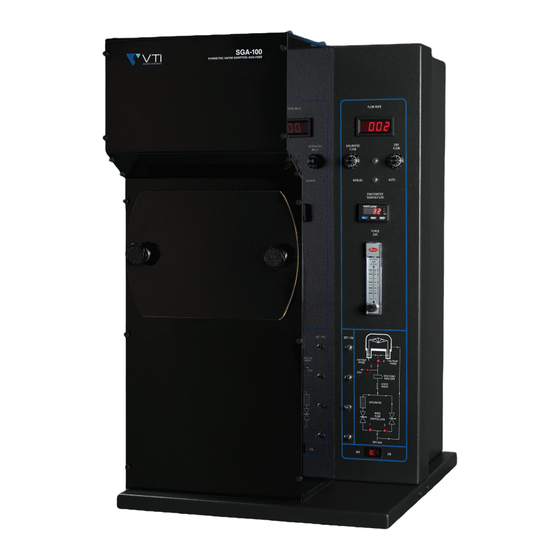
Table of Contents
Advertisement
Quick Links
Advertisement
Table of Contents

Summary of Contents for VTI SGA-100
- Page 6 Rev H, 3/05/08 Calibration Protocol (short version) A. General The performance of the VTI water sorption analyzers is checked by running standard samples with known sorption behavior. The deliquescence point of sodium chloride (NaCl) at 25 C and the known amount of water sorption at 80% RH at 25 C of (PVP) Polyvinylpyrrolidone (irrespective of molecular weight), test the instrument performance.
- Page 7 0.001% every 5 minutes (CAHN & CIE Balance) Max equilibrium time: 200 min Start % RH: 10 % Maximum % RH: 80 % Steps: 10%, 20%, 80% Quantity of sample: 3 to 3.5 mg 2 of 3 VTI TN #0008, Rev H, 3/5/08...
- Page 8 46 wt %) in vacuum systems. Figure 3: A typical adsorption isotherm for PVP Sorption Isotherm 41.92790222 Adsorption 7.232872963 3.727888823 END OF PROCEDURE ________________________________________________________________ Effective Date: March 5, 2008 Approval:______________________________ Agustin Venero, Laboratory Director ________________________________________________________________ 3 of 3 VTI TN #0008, Rev H, 3/5/08...
- Page 9 Rev B, 9/18/04 SGA-100 Org Sample & Evaporator Temperature RTDs’ CALIBRATION Scope of VTI TP 0015 The RTD Temperature Calibration procedure applies to the VTI SGA-100 models with organic option only. Purpose The purpose of this procedure is to ensure that the Sample and Evaporator RTD Temperature Probes are properly calibrated for operation.
- Page 10 Document accumulated numbers in macro spreadsheet The slope and intercept will be computed along with R² which should not be lower than .9998. _______________________________________________________________ Effective Date: September 18, 2004 _Approval: ______________________ Henry Barnard, Operations Dir ________________________________________________________________ VTI TP #0015, Rev B, 9/18/04 2 of 2...
Need help?
Do you have a question about the SGA-100 and is the answer not in the manual?
Questions and answers